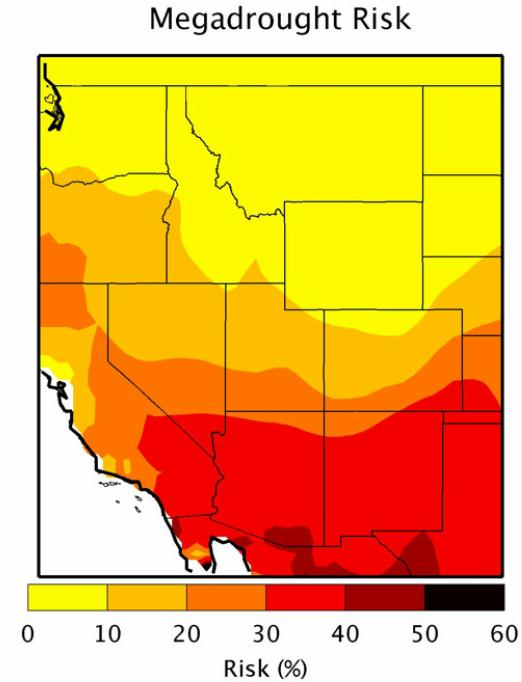
Preface. Mother Nature has had enough and is biting us back. Climate change will increase the chance of a Southwest megadrought that lasts longer than those in the past.
Keep up with the latest drought news at the U.S. Drought Monitor.
Alice Friedemann www.energyskeptic.com author of “When Trucks Stop Running: Energy and the Future of Transportation”, 2015, Springer, Barriers to Making Algal Biofuels, and “Crunch! Whole Grain Artisan Chips and Crackers”. Podcasts: Collapse Chronicles, Derrick Jensen, Practical Prepping, KunstlerCast 253, KunstlerCast278, Peak Prosperity , XX2 report
***
Williams AP, et al. 2020. Large contribution from anthropogenic warming to an emerging North American megadrought. Science 368: 314-318
The drought in nine U.S. states, from Oregon and Montana down through California to New Mexico, lasted from 2000 to 2018 and was among the most severe to strike the region in the last 1,200 years, a new study finds. In the past megadroughts lasted from 50 to 90 years, and the hotter temperatures of today could make this and future droughts even worse.
Tree ring–based reconstructions of past climate from 1586 sites in the Western U.S. reveal just one drier 19-year period: a powerful “megadrought” from 1575 to 1593 that may have contributed to the abandonment of Anasazi from their settlements in Arizona, New Mexico, Colorado, and Utah. Plus caused a faster, more devasting spread of disease brought by Spanish conquistadors.
The 16th century megadrought coincided with a powerful La Niña event. And in the last two decades there’ve been more La Nina than El nino years.
But we can’t blame it entirely on La Nina.
It’s up to half due to climate change and rising temperatures. Hot air holds more moisture which it absorbs from shrubs, trees and the ground, drying them out. It also reduces snowpack and river flows, and increases wildfire seasons. Climate change makes the difference between a manageable drought and severe consequences, and makes it more likely this megadrought will continue.
So much groundwater was used to cope that the region’s safety net is mostly gone. There’s a 50% chance Lake Mead will dry up by 2050 and a 10% chance it will dry up by 2021.
If this turns into a long megadrought it would be catastrophic for California’s 40 million people, farm production cut in half, and ecosystems suffer the most of all.
And the population of the Southwest continues to grow exponentially.
***
Likely future consequences:
Escobar, H. Feb 20, 2015. Drought triggers alarms in Brazil’s biggest metropolis. Science 347: 812. Driven by a mysterious atmospheric anomaly, a 2-year-long drought has triggered a crippling water crisis in southeast Brazil, a region of 85 million people that includes the nation’s biggest metropolis, São Paulo. The São Paulo government has reduced the water pressure in its mains, which regularly leaves faucets running dry. And it is now taking a carrot-and-stick approach to water usage, financially rewarding those who conserve and fining those who waste. Barring a sudden reversal of meteorological misfortune, officials are contemplating drastic rationing that would deprive millions of households of water for up to 5 days a week. “We are talking about the possible collapse of our most important water supplies.” Some are bracing for rioting. “There is a real risk of social convulsion,” warns José Galizia Tundisi, a hydrologist with the Brazilian Academy of Sciences.
A ‘megadrought’ will grip U.S. in the coming decades, NASA researchers say. Researchers from NASA and Cornell and Columbia universities warned of an 80% chance of mega-droughts lasting up to 40 years in the southwest and central USA, with major water shortages. This dries out vegetation, which can lead to monster wildfires in like recent fires in southern Arizona and parts of California.

5 Responses to Megadrought invades the West